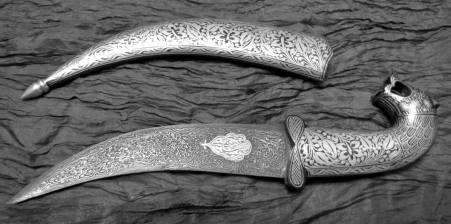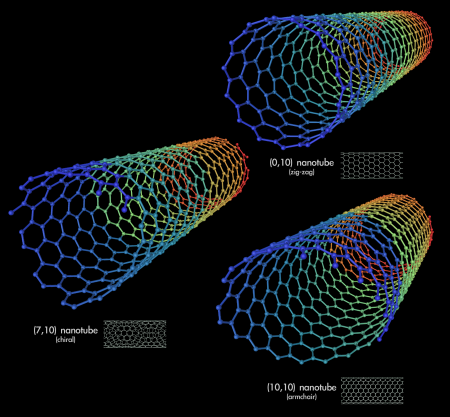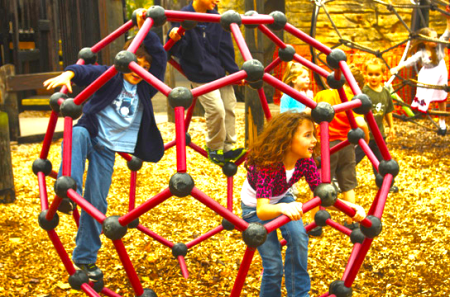Since our early ancestors first learned to make fires, humans have been producing carbon-based nanoparticles. The smoke and soot from their campfires contained nanoparticles known as fullerenes and carbon nanotubes, along with many other combustion by-products. They must have thought the very crude nanoparticle preparations they created were a bit of a nuisance (depending on how concerned they were about cleanliness), until they decided they could use them in art. Little did they realize that some of the structures in the smudgy black stuff they made would some day help solve our energy problems.

Thousands of years later, in the 11th to 13th centuries C.E., the Crusaders encountered unusually strong and sharp sword blades when then fought against Muslims. Part of the reason for the exceptional strength, remarkable sharpness, and beautiful patterns on the surface of the Damascus steel sword blades used by Saladin’s troops may have been the presence of carbon nanotubes in the steel used. Scientists looking at such sword blades under the electron microscope have seen evidence of carbon nanotubes (and other nanomaterials) in Damascus steel.

Fast forward 800 years to 1985. Richard Smalley, a professor chemistry, physics and astronomy at Rice University, found remarkably stable clusters of 60 carbon atoms were produced when he shot a laser at a sheet of graphite (the material pencil “lead” is made of). These clusters look something like a soccer ball or the geodesic domes designed by Richard Buckminster “Bucky” Fuller and are called fullerenes or buckyballs.

Within a few years Smalley and other scientists had discovered a whole host of variations on the fullerene theme including carbon nanotubes. To be fair, Soviet scientists took pictures of some with an electron microscope in the early 1950s, but not many people noticed. Smalley and others also learned how to make relatively large quantities of these nanomaterials (ok, not so large, less than an ounce at a time, but we have made progress since then). Some of these structures were later shown to occur in nature and to be produced when we burn things. In 1996, Smalley and two colleagues received the Nobel Prize in Chemistry for their discovery of fullerenes as a new form of carbon. To my knowledge, our early ancestors were not even mentioned in his acceptance speech.
So, now that we can make fullerenes and carbon nanotubes in large quantities, are they useful for anything other than cave paintings? I’m glad you asked! Fullerenes and carbon nanotubes have a number of properties that make them useful. Fullerenes have antioxidant properties. Additionally, when light is shined on them, they produce reactive forms of oxygen that can kill bacteria and viruses. Carbon nanotubes are among the strongest materials on Earth. They are many times stronger and lighter than steel. Carbon nanotubes look something like a roll of chicken wire. Depending on how the chicken wire is rolled, carbon nanotubes can be conduct electricity (“metallic” carbon nanotubes), act as semiconductors, or not allow passage of electricity. Metallic carbon nanotubes can carry 1000 times more electricity for their size than the copper wire in the walls of your house.

Fullerenes and carbon nanotubes are already being incorporated into products, and they have numerous prospective uses that promise to help us deal with our energy needs. Fullerenes are being incorporated into cosmetics, especially skin rejuvenation formulations. Researchers are looking into ways use their antibacterial properties to treat infections and make anti-bacterial surfaces. They are also being investigated for use as drug delivery devices.
So far, carbon nanotubes have mostly been used in forms that don’t allow us to take advantage of some of their coolest properties. Because of their strength and lightness you’ll find them in bicycle components, tennis rackets, golf clubs, and skis. These applications may improve your race time or decrease fatigue during a game, but future applications have the potential to profoundly change society. Just consider a few examples. Carbon nanotubes can be used to make ultralight and strong materials that when used in aircraft and cars will dramatically reduce energy usage. They may also be used to make stab-proof and bulletproof clothing, and perhaps even space elevators. Metallic carbon nanotubes may be used to further miniaturize electronics (you thought the iPod nano was small …), in the development of paper batteries, and to increase the efficiency of solar cells.
Who knew that that something in that smudgy black stuff our early ancestors produced in their campfires could have so many amazing uses!? We are even using carbon nanomaterials to teach the next generation about nanoscience. The cool shapes of buckyballs and carbon nanotubes make them interesting to kids (and adults). Some of our colleagues made some very large versions of these materials to teach kids about nanotechnology at the Carbon Playground at the Discovery Center Museum in Rockford, Illinois.


